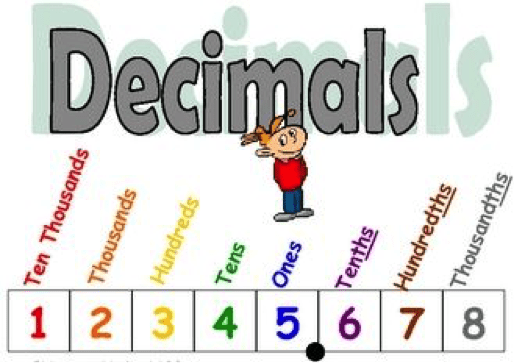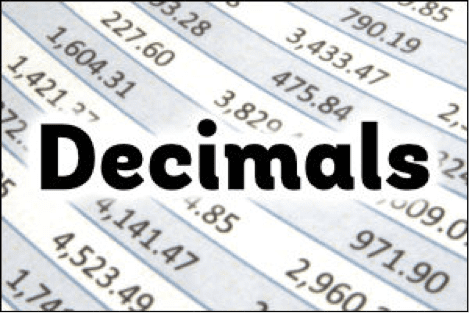
Also Read: Forex Trading for Dummies
Contents
- What Is a Decimal?
- Decimal Place Value
- Four Decimal Places
- Four Decimal Place Value Explained
- How to Express a Decimal in Words
- Rounding up with Decimals
- Fractions vs Decimals
- Conclusion
- FAQs
What Is a Decimal?
In decimal notation, the decimal point, popularly called the base ten systems, reflects mixed and fractional numbers. A decimal point distinguishes the components of the following number from the whole number. Decimal is derived from the Latin word decimals, which means “tenth.”
The following are some examples of decimal notation:
- 03
- 067
- 1
- 8
- 0000001
- 9979
In each of these examples, the placement of the decimal numbers tells us how big (or small) the number is. A small decimal point in an incorrect place can lead to a major error.
Decimal Place Value
The place value of integers lower than one is referred to as the decimal place value. Place value may be apparent to you in bigger numbers, but it operates in the same manner with extremely tiny numbers.

For example, the place value for the integer 2.34567 is as follows:
- 2 – ones place
- 3 – tenths place
- 4 – hundredths place
- 5 – thousandths place
- 6 – ten thousandths place
- 7 – hundred thousandths place
By shifting the decimal point towards the right, you may increase the number by a factor of 10. For instance:
- 34567 x 10 = 23.4567
- 4567 x 10 = 234.567
- 567 x 10 = 2345.67
By moving the decimal point to the left, you may reduce the number by a factor of 10. For instance:
- 34567 ÷ 10 = 0.234567
- 234567 ÷ 10 = 0.0234567
- 0234567 ÷ 10 = 0.00234567
Knowing how the decimal affects the magnitude of a number may make multiplication much easier to comprehend. Depending on where the decimal is placed, it can also assist you in determining if a number is very enormous or very little.
Four Decimal Places
The ones placing is a decimal place to the left of the decimal point. The tenths place is one decimal place to the right of the decimal place. Keep a keen eye on the numbers to see the location of decimal places.
Furthermore, what is the decimal equivalent of the tenth place? When a number has a decimal point, the number of tenths is shown by the 1st digit to the right of the decimal point.
The decimal 0.5, for example, is very much like the fraction 3/10. The number of hundredths is indicated by the 2nd digit to the right of the decimal point.
Similarly, what is the term for the decimal .00001?
- .001 = thousandth.
- .0001 = ten-thousandth.
- .00001 = hundred-thousandth.
- .000001 = millionth.
How much is 4 decimal places?
When stated in decimal notation, four decimal places means four (or less) digits to the right of the decimal point, e.g. 54.6789. In scientific work, one would often fill a number with fewer than four digits, thus 5.33 would’ve been rendered as 5.3300 to represent its precision level.
Four Decimal Place Value Explained
The decimal component of a number may be thought of as a fraction with a denominator of a multiple of ten. The whole number component of 54.3, for example, is 54, while the decimal half is 3 tenths.
Place value titles for whole numbers, such as ones, tens, and hundreds, are the same as place value identities for decimal numbers to the right of the decimal point.
These are shown below. In this lesson, we’ll look at decimals with up to 4 decimal places, or integers with up to a ten-thousandths value.
Let’s go through the labels of the place value fields again.

In a case where we have the decimal 0.78, we may write it on the place value system as shown below, indicating that 0.78 has 7 tenths and 8 hundredths.

In decimal, the zeros are very crucial. The place value is represented by the zeros in between decimal points as well as the digits. 0.91, 0.091, and 0.0091, for example, can not have the same value. One can see this by putting these numbers as fractions, yielding three unique fractions:

Therefore, we may put zeros to the right of a last digit in decimal and the result will remain unchanged. So, 0.91, 0.910, and 0.9100 have the same value because we can express or write them in fractions and deconstruct them, yielding:

How to Express a Decimal in Words
- Like a whole number, consider the digits to the right from the decimal place. let’s take, for instance, 0.099, one would express these digits as “ninety-nine.” We can omit any zeros just after the decimal point, and before the numeric digits when stating it as a whole number.
- Over the last decimal digit just on right, utilize the place value description. Thousandths is the last decimal digit place value in 0.099.
- Bring them together. In English, 0.099 is “ninety-nine thousandths.”
Rounding up with Decimals
The procedure for rounding decimals is identical to that for rounding entire numbers. When the digit in question is a 4, 3, 2, or 1 the digit to its left remains constant, which rounds down. If it is 5 or above, the digit to its left increases by plus 1 which rounds up.

For instance, if you round up to a decimal place or you rounded to the nearest one:
- 8 rounds up to 5. (8 tenths rounds up to one, so 4 + 1 = 3)
- 3 rounds down to 90 (3 tenths rounds down to zero, so 90 + 0 = 90)
- 6 rounds up to 2 (6 tenths rounds up to one, so 1 + 1 = 2)
- 4 rounds down to 456 (4 tenths round down to zero, so 456 + 0 = 456)
The same is applicable, whether rounding to 2 decimal places or to the nearest tenth.
- 68 rounds up to 5.7 (the 8 hundredths round up to one tenth, so 2.6 + 0.1 = 5.7)
- 83 rounds down to 45.8 (the 3 hundredths rounds down to zero tenths, so 45.8 + 0.0 = 45.8)
- 38 rounds up to 4.4 (the 8 hundredths round up to one tenth, so 4.3 + 0.1 = 4.4)
- 82 rounds down to 796.8 (the 2 hundredths round down to zero tenths, so 796.8 + 0.0 = 798.8)
When we round to three decimal places, the result is as follows:
- 374 rounds down to 5.37 (the 4 thousandth rounds down to 0 hundredths, so 5.37 + 0.00 = 5.37)
- 437 rounds up to 58.44 (the 7 thousandths rounds up to 1 hundredth, so 58.43 + 0.01 = 58.44)
- 672 rounds down to 0.67 (the 2 thousandths rounds down to 0 hundredths, so 0.67 + 0.00 = 0.67)
- 238 rounds up to 654.24 (the 8 thousandths rounds up to 1 hundredth, and 654.23 + 0.01 = 654.24).
The rounding principle holds true when you round to 4 decimal places or to the nearest thousandth, 5 decimal places, or to the nearest ten thousandths, 6 decimal places, or the nearest hundredth, below that.
Since the digits to the right of a decimal point are portions of the following number, rounding up fills in several of the gaps.
Also Read: Curve Finance: How Does It Work?
Fractions vs Decimals

Decimals are just fractions represented in a linear format. They both feature number portions as well as complete numbers. Their system differs solely in the accompanying ways:
Fractions split the numerator (main number) from the denominator (dividing number) by a fraction line.
Decimals distinguish the component from the total with a decimal point.
The figures 2/3 and 0.667 are the same number: two-thirds. The fraction illustrates that there are two parts available out of three, and the decimal figure illustrates that 667 parts are available out of 1000. They are simply various methods of expressing the same idea.
Conclusion
Decimal places and whole numbers are major expressions of numbers. 4 decimal places include all numbers except any number that comes after the 4th from the decimal point.
Rounding up and approximations help under decimals and fractions better.
FAQs
How do you count decimal places?
When a figure comes with a decimal, the 1st number to the right of the decimal shows the number of tenth. For instance, the decimal figure 0.6 has the same meaning as 6/10. The second figure to the right of the decimal is the number of hundredth, and so on.
What are two decimal places?
Rounding up a figure to the hundredth place is the same as rounding up to 2 decimal places. This is the 2nd place to the right, counting from the decimal point. A good example is 4.24334 can be rounded up to 2 decimal places as 4.24, and 0.5432 is 0.54 when rounded up to 2 decimal places.
What does 3 decimal places mean?
Approximating to the thousandths place in a decimal figure is the same as rounding up to 3 decimal places. This basically implies that figures must not have any numbers after the 4th place. 543.12345 rounded up to 3 decimal places, is 543.123.
What is a decimal place value?
The decimal point of a figure shows the place value of a decimal figure. The tenth is illustrated using the first number from the dot or decimal. The hundredth is the 2nd number to the right, which completes 2 decimal places. 0.07 can be rewritten as 7/100 in a fraction.



